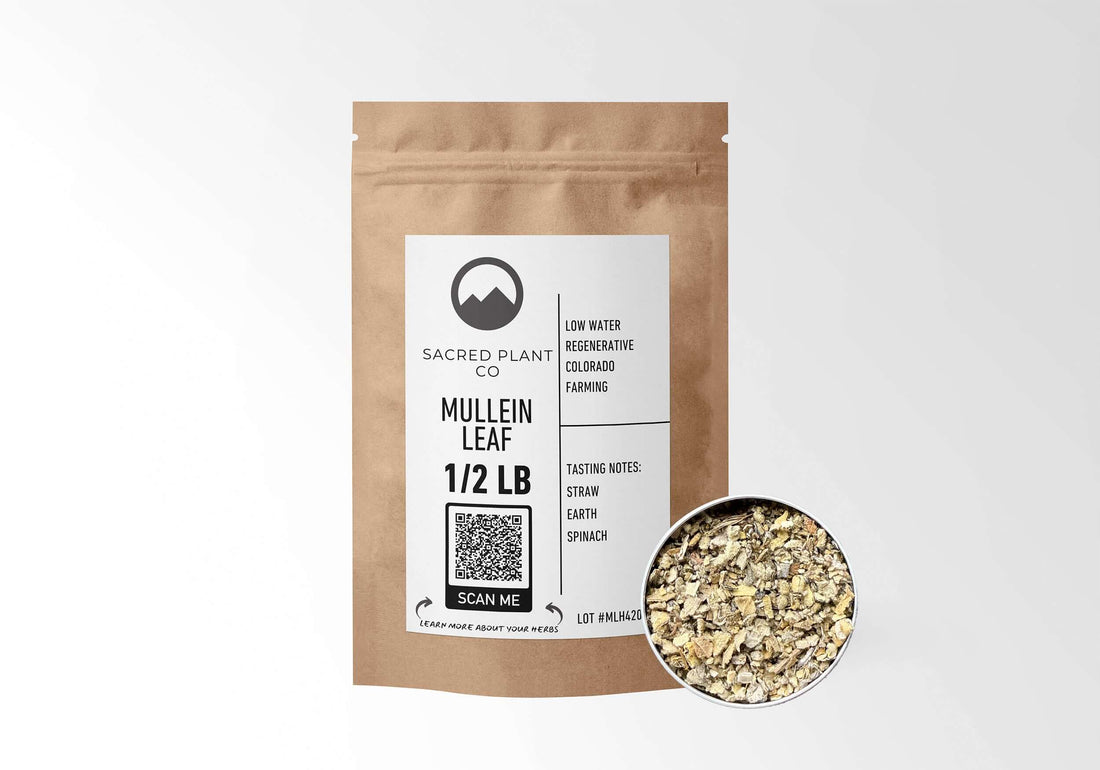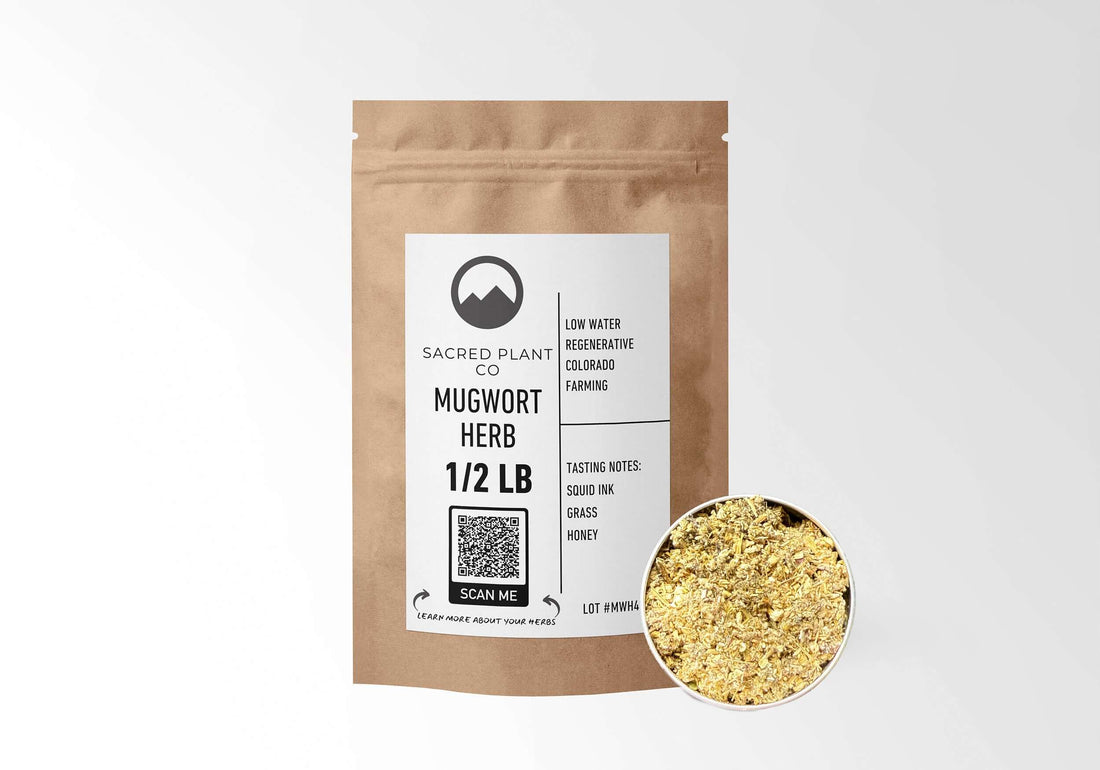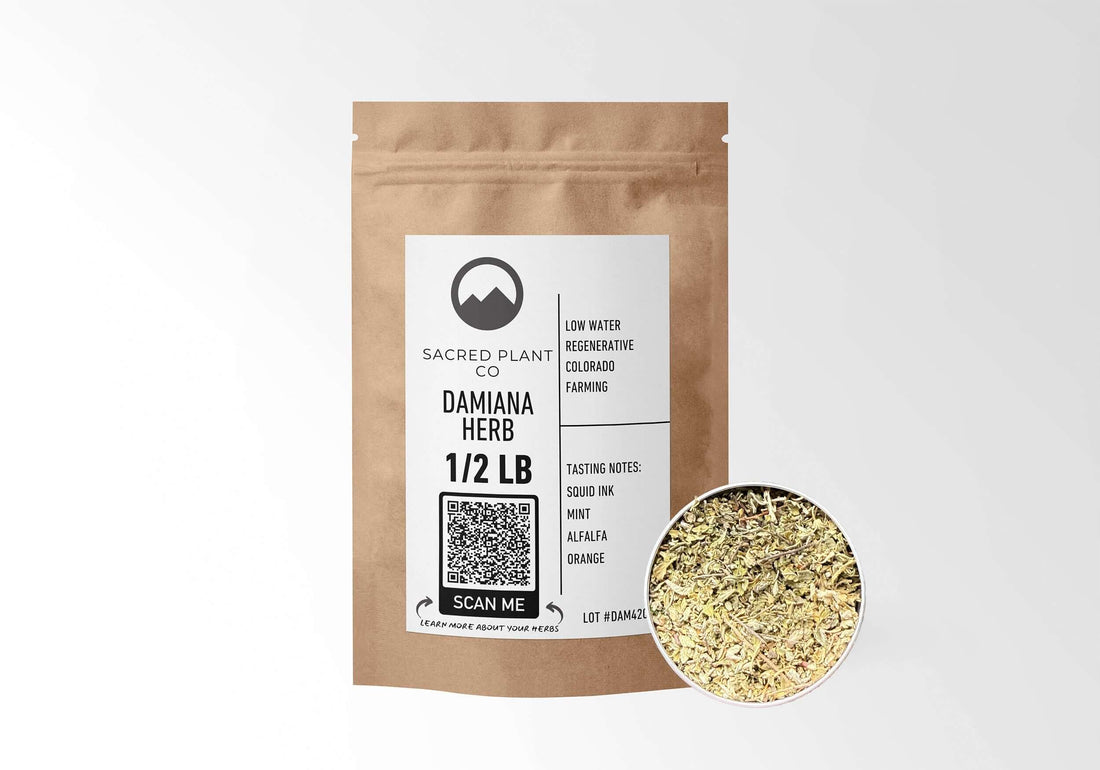Mullein, Mugwort, Damiana: What Each Herb Does When Smoked (How & Why)
When we talk about smokable herbs, three names rise above the rest for their centuries-old use and distinct effects. Mullein soothes the respiratory tract, mugwort unlocks the dream world, and damiana gently lifts mood while relaxing the body. Each plant brings something different to the practice of herbal smoking, but understanding what they do and why they work matters if you want to use them safely and intentionally.
We've gathered research from ethnobotanical archives, peer-reviewed studies, and traditional herbalism to build this monograph. You'll find botanical chemistry, historical context, modern cautions, and practical guidance for each herb. This is the reference article that supports our broader work on smokable herbs.
Related reading: For a complete overview of smoking herbs, see our Ultimate Guide to the Best Herbs for Smoking.
Mullein: The Respiratory Ally
What Mullein Does
Mullein (Verbascum thapsus) has earned its reputation as a gentle respiratory herb. The leaves contain mucilage, saponins, and flavonoids that coat irritated tissues and help loosen stubborn mucus.1 Traditional herbalists smoked mullein to ease congestion, calm coughs, and open constricted airways. The Navajo people called it "big tobacco" and used it ceremonially and medicinally for lung support.2
Modern research confirms that mullein possesses anti-inflammatory and expectorant properties.3 Studies suggest the plant's compounds may reduce airway inflammation and help expel phlegm, making breathing easier during respiratory distress. One clinical review noted mullein's potential to soothe bronchial irritation, though it emphasized that more rigorous trials are needed.4

Bulk Mullein Leaf
Premium dried mullein leaves, perfect for smoking blends, teas, and respiratory support preparations.
Shop Mullein LeafWhy Mullein Works When Smoked
Smoking mullein delivers its active compounds directly to lung tissue. The mucilage forms a protective layer over inflamed airways, while saponins act as mild expectorants. Flavonoids like quercetin contribute anti-inflammatory effects that may calm reactive tissues.5 The smoke itself is notably smooth and mild compared to other herbs, which is why mullein often serves as a base ingredient in herbal smoking blends.
The key mechanism lies in mullein's demulcent action. Demulcents create a soothing film over mucous membranes, reducing irritation from dryness or coughing. When inhaled, these compounds coat the throat and bronchial passages almost instantly.
How to Use Mullein Safely
Dry the leaves thoroughly before smoking to avoid harsh smoke. Crumble them into a fine texture and use alone or blended with complementary herbs. Start with a small amount (a pinch in a pipe or rolled cigarette) to assess your response. Mullein does not produce psychoactive effects, so you won't experience a "high."
Mullein works beautifully in combination. Pair it with peppermint for a cooling effect, or blend it with damiana for mood support. Many herbalists use mullein as a base (60-70% of the blend) and add smaller amounts of other herbs for flavor and function.
Cautions and Contraindications
Important safety note: Despite mullein's traditional use for lung support, all smoke contains particulate matter, tar, and carbon monoxide that can irritate lung tissue over time.6 Research on herbal asthma remedies found that chronic smoke inhalation (even from therapeutic herbs) may contribute to emphysema and chronic obstructive pulmonary disease.7
If you have asthma, COPD, or any respiratory condition, consult a healthcare provider before smoking mullein or any herb. Pregnant and breastfeeding individuals should avoid smoking entirely. For those seeking respiratory benefits without inhalation risks, consider mullein tea, tinctures, or steam inhalations instead.
Mugwort: The Dreamweaver
What Mugwort Does
Mugwort (Artemisia vulgaris) has followed humans across continents for thousands of years. Ancient Greeks, Celtic druids, and Chinese medicine practitioners all turned to mugwort for dream enhancement, spiritual work, and nervous system support.8 The plant's reputation as a "dreamweaver" comes from consistent anecdotal reports of vivid dreams, improved dream recall, and occasionally lucid dreaming when used before sleep.
Mugwort contains several active compounds including thujone, flavonoids, and volatile oils that may influence the nervous system. While rigorous clinical studies remain scarce, herbalists describe mugwort as having mild nervine and oneirogenic (dream-inducing) properties.9 Traditional Chinese medicine uses mugwort in moxibustion, burning it near acupuncture points to balance energy flow.

Mugwort (Handpicked, Regeneratively Grown)
Premium handpicked mugwort for dreamwork, ceremonial smoking blends, and traditional practices.
Shop MugwortWhy Mugwort Affects Dreams
The mechanism behind mugwort's dream effects remains somewhat mysterious. Thujone may stimulate the central nervous system in small doses, potentially increasing mental activity during REM sleep when most vivid dreaming occurs.10 Some researchers theorize that mugwort's aromatic compounds influence neurotransmitter activity, though definitive evidence is lacking.
What we do know from centuries of use: mugwort appears to intensify whatever dream state you naturally experience. If you rarely remember dreams, mugwort may help you recall fragments. If you dream vividly, mugwort may amplify color, detail, and emotional intensity. The effect seems dose-dependent and highly individual.
How to Use Mugwort for Dreamwork
For dream enhancement, use mugwort 30-60 minutes before bed. Smoke a small amount (3-5 inhalations from a pipe) or brew a light tea (1 teaspoon dried herb steeped 5-7 minutes). You can also place dried mugwort in a small sachet near your pillow to inhale the aroma throughout the night.
Keep a dream journal by your bedside. Mugwort may increase dream vividness, but you'll lose those details quickly upon waking unless you record them immediately. Many practitioners combine mugwort with intention-setting practices: meditation, breathwork, or visualization before sleep.
When smoking mugwort in blends, use it as 20-40% of the total mixture. It pairs well with lavender for calming effects, or with passionflower for deeper relaxation. Some ceremonial blends include mugwort with rose petals and motherwort for balanced, grounding dreamwork.
Cautions and Contraindications
Do not use mugwort if you are pregnant or trying to conceive. Mugwort is a traditional emmenagogue (uterine stimulant) and has been used historically to bring on menstruation.11 Even small amounts may affect reproductive function.
Mugwort contains thujone, which can be neurotoxic in high doses. Smoking small amounts occasionally poses minimal risk, but do not use mugwort as a daily tonic herb. Some individuals experience allergic reactions to mugwort pollen, particularly those sensitive to ragweed or other Asteraceae family plants.12
The smoke from burning mugwort during moxibustion has been studied and found to contain potentially harmful compounds.13 While traditional use involves brief exposure, regular or prolonged smoke inhalation carries respiratory risks regardless of the herb used.
Damiana: The Mood Lifter
What Damiana Does
Damiana (Turnera diffusa) grows wild across Mexico, Central America, and the Caribbean. Indigenous peoples have used the aromatic leaves for centuries as an aphrodisiac, mood enhancer, and digestive aid.14 The Maya and Aztec cultures valued damiana for increasing sexual vitality and emotional well-being, traditions that continue in modern herbalism.
Damiana contains flavonoids (particularly apigenin and acacetin), volatile oils, tannins, and other compounds that may influence the nervous system. Research suggests these constituents have mild anxiolytic (anxiety-reducing) properties and may affect sex hormone metabolism.15 The plant's reputation as an aphrodisiac likely stems from both physiological effects and its gentle mood-lifting qualities that reduce stress and increase presence.
Why Damiana Works When Smoked
Smoking damiana delivers effects more rapidly than tea or capsules. Terpenes in damiana may stimulate dopamine release, the neurotransmitter associated with pleasure and motivation.16 The herb also contains aromatase, an enzyme that converts testosterone to estrogen, potentially affecting hormonal balance in both men and women.
Users typically report gentle relaxation, mild euphoria, and improved mood within 10-15 minutes of smoking. The effects last 1-2 hours and fade gradually. Damiana doesn't produce intense psychoactive effects, but rather creates a subtle shift toward calm focus and body awareness.

Bulk Damiana Herb
Fresh, aromatic damiana leaves for mood enhancement, relaxation blends, and traditional preparations.
Shop DamianaHow to Use Damiana Safely
Damiana has a pleasant, slightly sweet flavor with notes reminiscent of chamomile or fig. Start with a small amount (a pinch in a pipe) to gauge your individual response. Some people find the effects quite noticeable, while others experience only mild relaxation.
Damiana blends beautifully with other herbs. Combine it with mullein for a smoother smoke, add peppermint for freshness, or mix it with cannabis to extend and enhance effects. Traditional Mexican preparations sometimes include damiana with other aphrodisiac herbs in ceremonial contexts.
For mood support without smoking, steep 1-2 teaspoons of dried damiana in hot water for 10-15 minutes. The tea has a more pronounced effect than smoking but takes 30-60 minutes to peak.
Cautions and Contraindications
Pregnant and breastfeeding individuals should avoid damiana entirely. The herb's effects on reproductive hormones make it inappropriate during pregnancy. People with hormone-sensitive conditions should consult a healthcare provider before use.
Damiana may lower blood sugar levels. If you take diabetes medications, monitor your blood sugar closely and discuss use with your doctor. In very high doses, damiana has been reported to cause hallucinations, though this is rare with typical smoking amounts.17
As with all smokable herbs, regular inhalation carries respiratory risks. Damiana smoke contains tar, carbon monoxide, and other combustion byproducts that can irritate lung tissue over time.
Learn more: Discover premium blend recipes in our guide to Herbal Smoking Blends for Calm, Clarity, and Ceremony.
How to Combine These Herbs Safely
Building Effective Blends

Each herb brings distinct qualities that complement the others. Mullein provides smooth smoke and respiratory support, mugwort adds dreamwork and spiritual dimension, and damiana contributes mood-lifting effects. A well-crafted blend balances these elements.
Try this foundational blend ratio:
- 50% Mullein – Base herb for smooth smoke
- 30% Damiana – Mood and relaxation
- 20% Mugwort – Evening dreamwork
Adjust proportions based on your intention. For stronger dreamwork, increase mugwort to 30% and reduce damiana. For daytime relaxation without dream effects, omit mugwort entirely and use 60% mullein with 40% damiana.
Why Each Step Matters
When blending herbs, dry all plant material thoroughly to avoid harsh smoke and potential mold. Crumble leaves to similar texture for even burning. Store blends in airtight glass containers away from light and moisture to preserve potency and flavor.
Mix small batches first (10-20 grams) to test proportions before making larger quantities. Label each blend with ingredients, ratios, and date created. This practice helps you track what works best for your individual needs and refine recipes over time.
Harm Reduction Practices
Critical information: Research consistently shows that herbal cigarettes produce harmful combustion byproducts similar to tobacco smoke.18 Even tobacco-free herbal smoke contains tar, carbon monoxide, aromatic amines, and other carcinogens formed during burning.
To minimize risks:
- Use herbs occasionally rather than daily
- Take fewer, shallower inhalations
- Consider vaporizers, which heat herbs without combustion
- Alternate between smoking and other preparation methods (tea, tincture, topical)
- Maintain good lung health through exercise and avoiding other irritants
If you experience persistent cough, shortness of breath, or chest tightness, discontinue use immediately and consult a healthcare provider. People with respiratory conditions should avoid smoking entirely and explore alternative preparation methods.
Safety & Disclaimer
Smoking any substance carries health risks. Herbal smoke contains tar, carbon monoxide, and other compounds that may harm lung tissue and increase cancer risk. People with asthma, COPD, cardiovascular disease, or other health conditions should not smoke herbs.
Mullein, mugwort, and damiana are not FDA-approved medicines. Traditional uses and historical applications do not constitute medical advice. These herbs are not intended to diagnose, treat, cure, or prevent any disease.
Pregnancy and breastfeeding: Do not use mugwort or damiana if pregnant, trying to conceive, or breastfeeding. Mullein safety during pregnancy has not been established.
Drug interactions: Mugwort and damiana may interact with medications affecting hormones, blood sugar, or the central nervous system. Consult your healthcare provider before use if you take prescription medications.
This article is for educational purposes only. Sacred Plant Co. recommends consulting qualified healthcare practitioners for medical concerns. Start with small amounts, observe your body's response, and prioritize safety above all.
References & Further Reading
1 Cleveland Clinic (2022). "Mullein Benefits: Is Mullein Good for Your Lungs?" health.clevelandclinic.org
2 Bear Blend (2023). "Smoking Mullein." bearblend.com
3 National Center for Biotechnology Information. "Searching for Scientific Explanations for the Uses of Spanish Folk Medicine: A Review on the Case of Mullein." pmc.ncbi.nlm.nih.gov
4 Medical News Today (2023). "Mullein for asthma: What are the benefits?" medicalnewstoday.com
5 Zhi Herbals (2024). "Can You Smoke Mullein Leaf?" zhiherbals.com
6 ACS Omega (2022). "How Do Herbal Cigarettes Compare To Tobacco? A Comprehensive Review." pubs.acs.org
7 NCBI (2010). "Emphysema due to smoke from a herbal asthma remedy." pmc.ncbi.nlm.nih.gov
8 Sacred Plant Co. (2024). "The Spiritual Use of Mugwort: The Dreamweaver for Intuition and Vision." sacredplantco.com
9 Commonwealth Herbs (2020). "Mugwort for Dreaming." commonwealthherbs.com
10 Herbal Academy (2020). "How to Use Mugwort for Dreams, Sleep, and More." theherbalacademy.com
11 NCCIH. "Mugwort: Usefulness and Safety." nccih.nih.gov
12 Medical News Today (2024). "Mugwort: Uses, side effects, and more." medicalnewstoday.com
13 Hindawi (2020). "Analysis of the components in moxa smoke by GC-MS." hindawi.com
14 Healthline (2023). "Damiana: An Ancient Aphrodisiac." healthline.com
15 Wikipedia. "Turnera diffusa." en.wikipedia.org
16 DoubleBlind Magazine (2024). "Smoking Damiana: Experts Weigh In on the Sexy Supplement." doubleblindmag.com
17 MedicineNet (2022). "Damiana: Depression Uses, Warnings, Side Effects, Dosage." medicinenet.com
18 GoodRx (2025). "Are Herbal Cigarettes Safe to Smoke? What Science Says." goodrx.com





